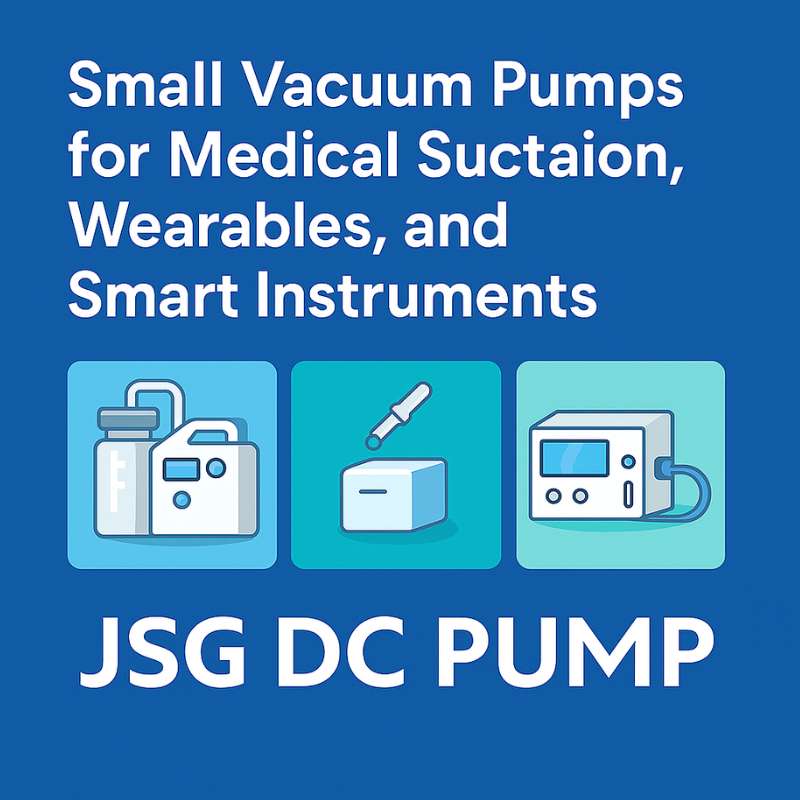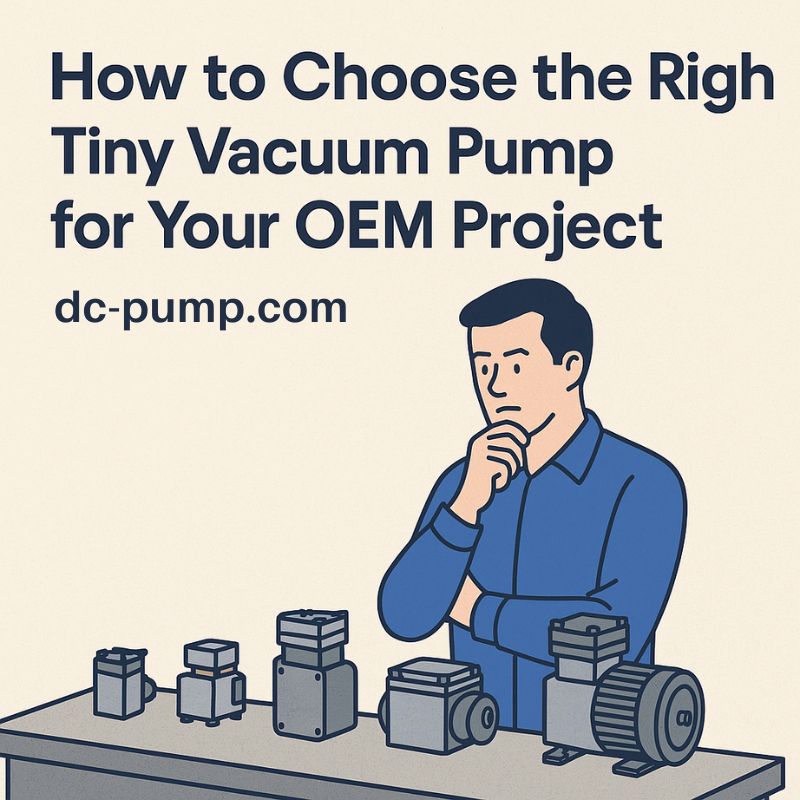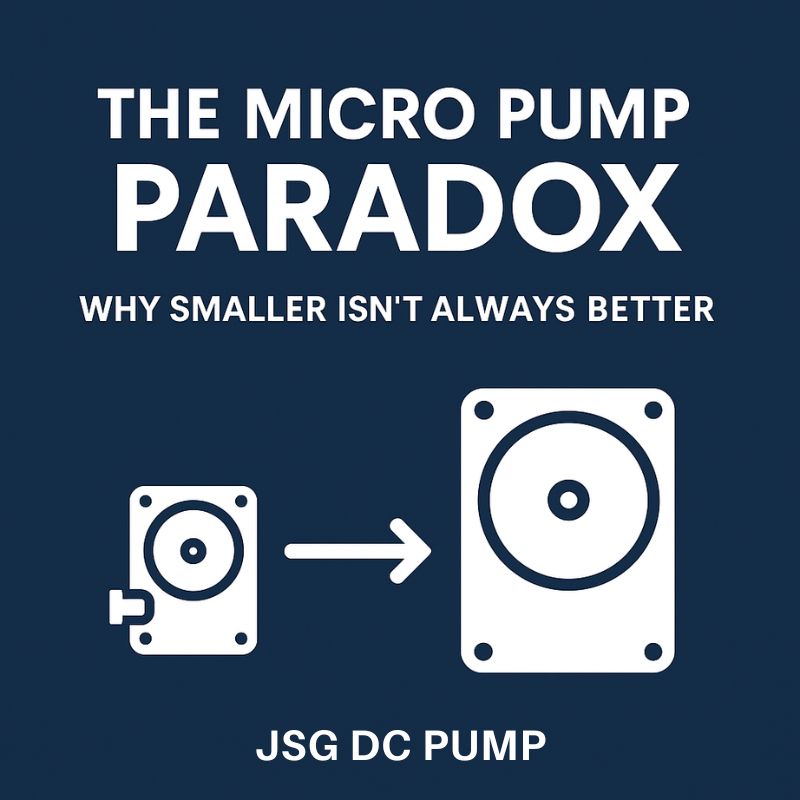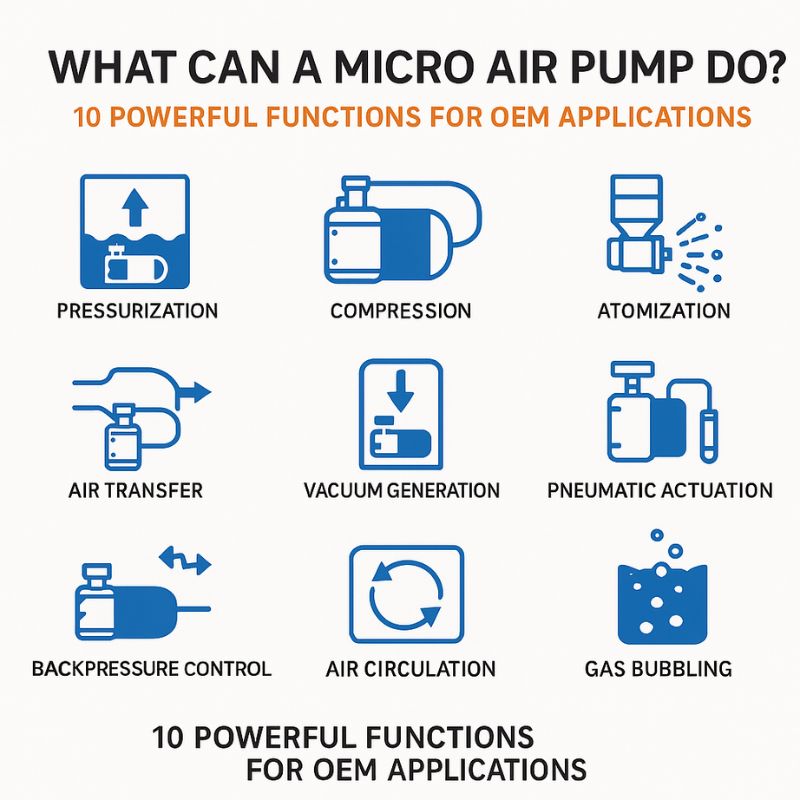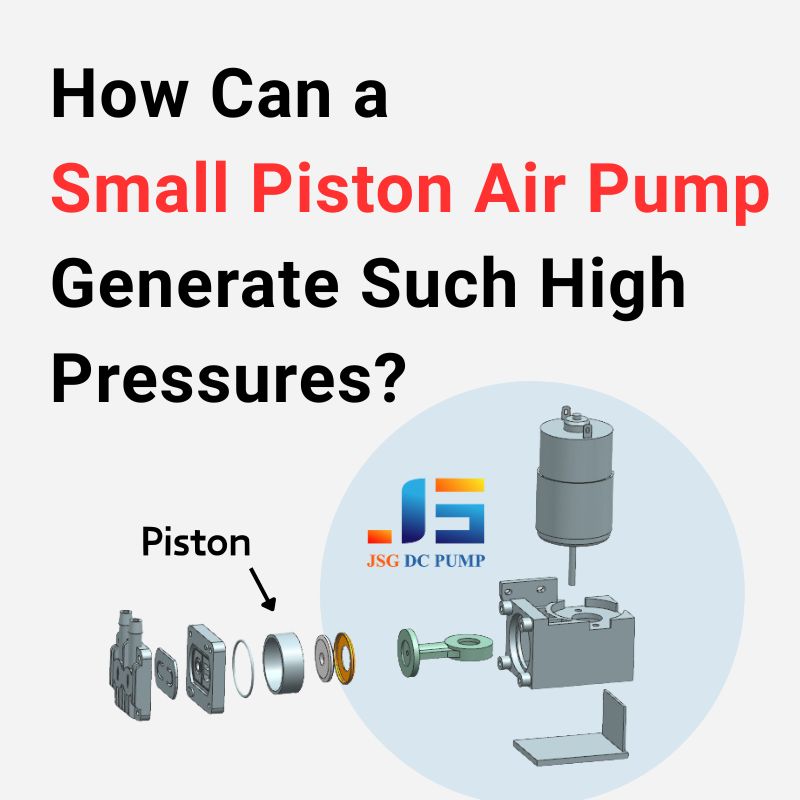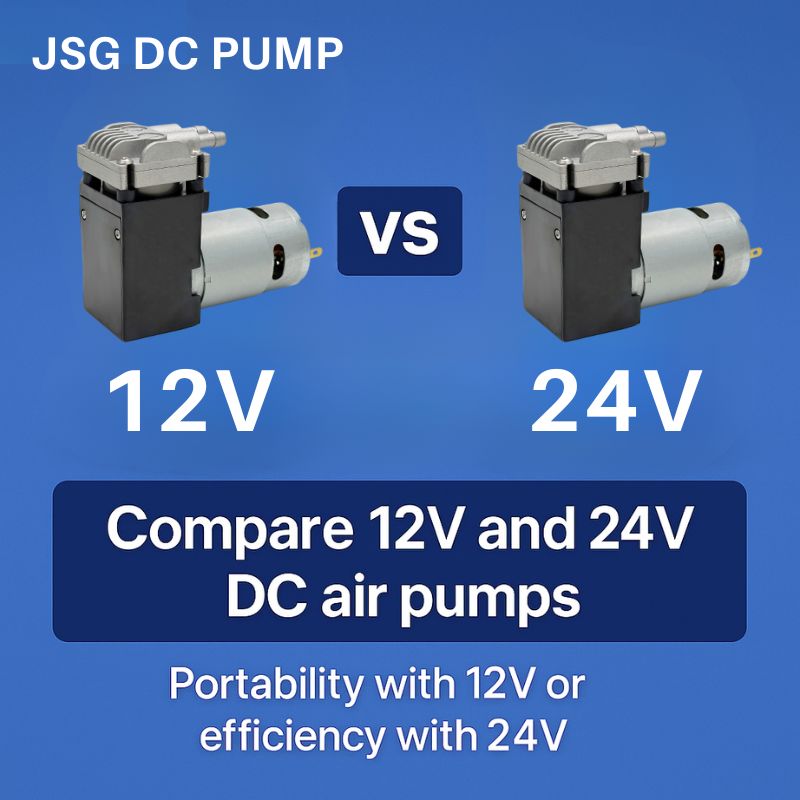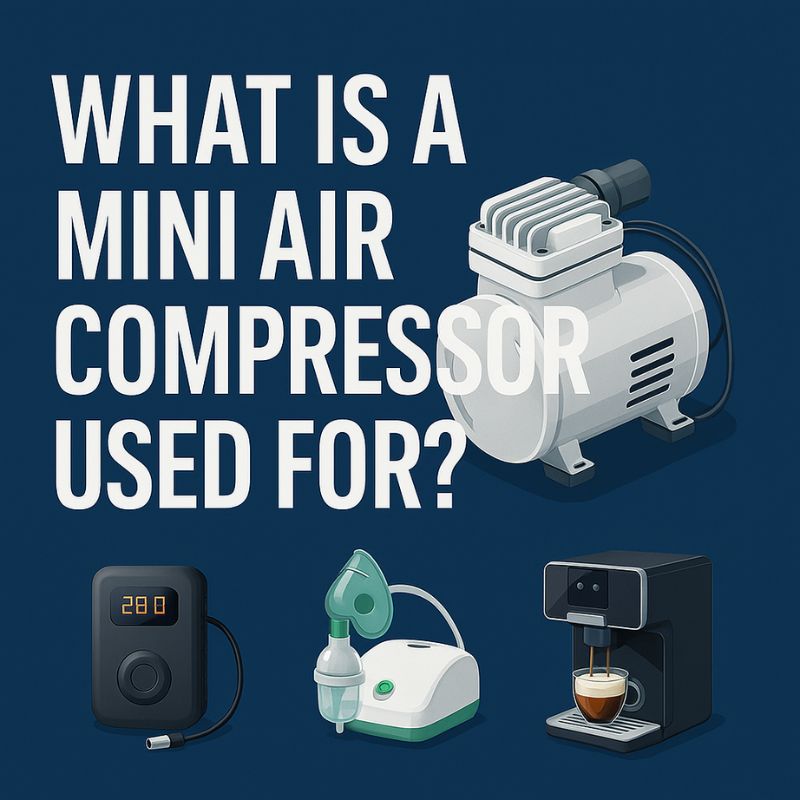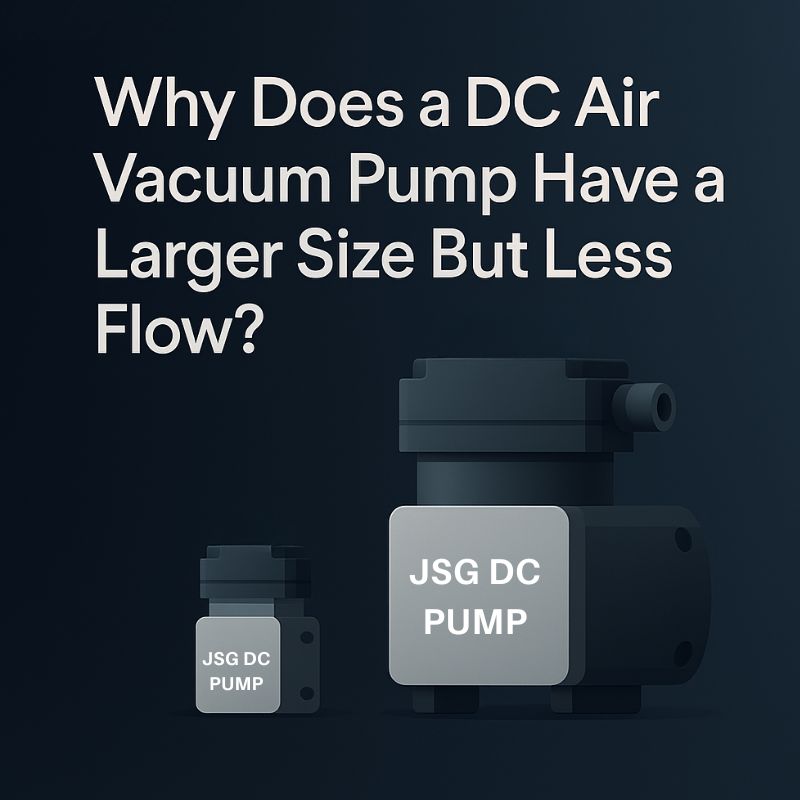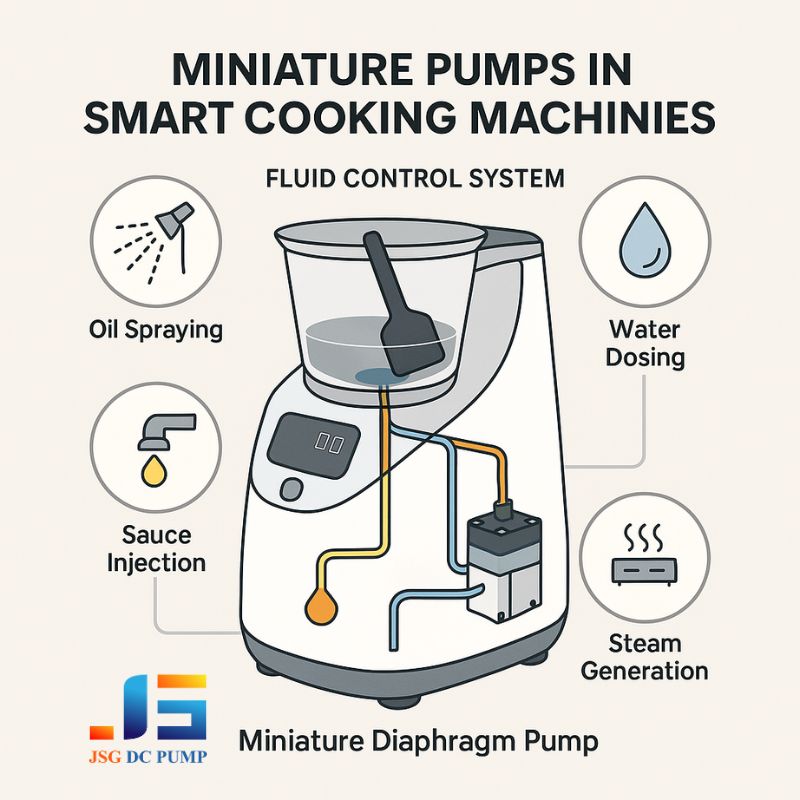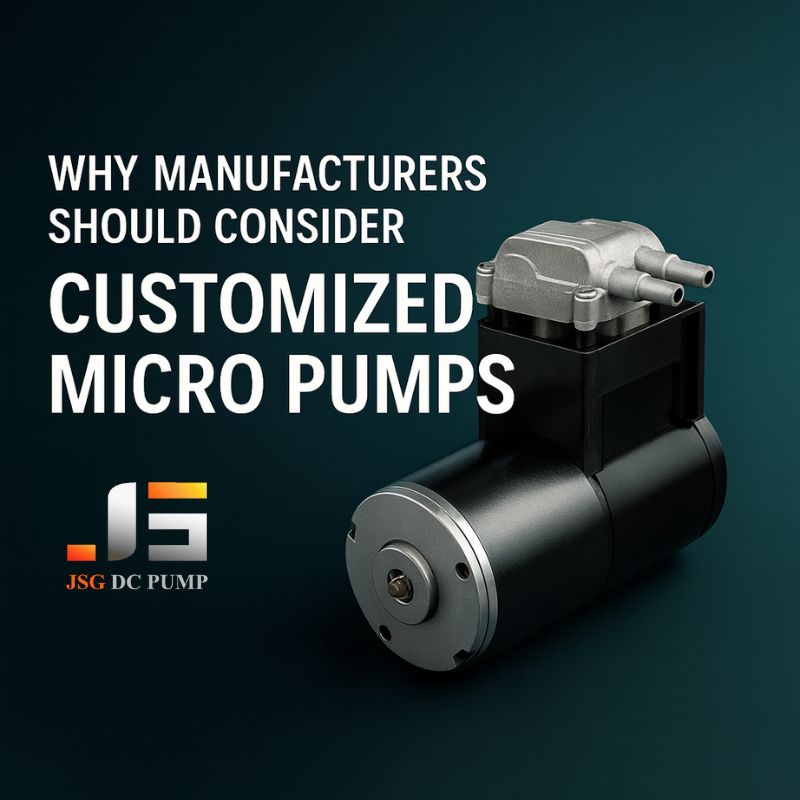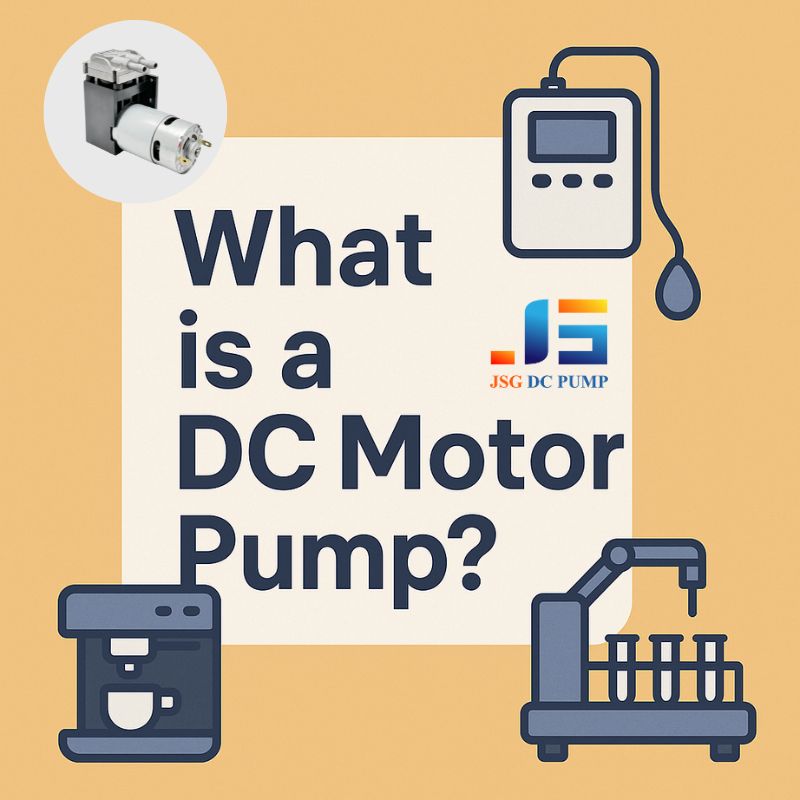The demand for smaller, smarter devices is exploding. But shrinking technology while maintaining performance is a huge challenge. Small vacuum pumps are quietly enabling these innovations, making the impossible possible.
Small vacuum pumps are crucial because they provide essential suction or negative pressure in a compact form factor. This enables the miniaturization of medical devices, the development of sophisticated wearables, and the functionality of smart instruments where space is at a premium.
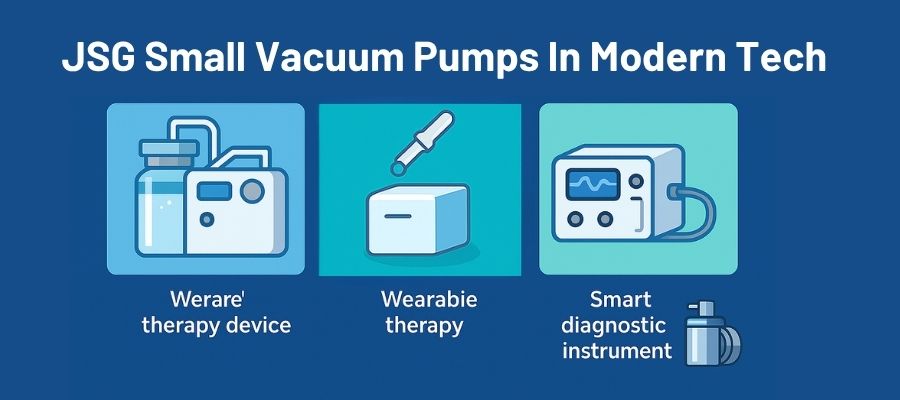
It’s fascinating to see how technology evolves. As an engineer at JSG DC PUMP with over two decades in the micro pump field, I’ve witnessed a dramatic shift towards smaller, more integrated solutions. Our mission to make mini pump knowledge accessible means helping you understand why these tiny powerhouses are becoming so vital. From life-saving medical equipment to the smart gadgets we use daily, the ability to create a vacuum in a tiny space is opening up a world of possibilities. Let’s explore how.
Why Is Small Size Vacuum Pump Technology Crucial in Modern Medical and Smart Devices?
Ever wonder how medical devices keep getting smaller yet more capable? The secret often lies in components like miniature vacuum pumps, driving innovation without compromising function.
Small vacuum pump technology is crucial because it allows complex functionalities, previously requiring bulky equipment, to be integrated into portable, user-friendly medical devices, wearables, and intelligent instruments, enhancing patient care and user experience.

The drive for miniaturization is relentless, especially in the medical and consumer electronics fields. At JSG DC PUMP, we’ve seen this firsthand. Think about portable oxygen concentrators, automated diagnostic tools, or even advanced wound therapy systems – they all need to be smaller, lighter, and often battery-powered.
Small vacuum pumps meet this need by providing the necessary suction or pressure difference without taking up much space or consuming excessive power. For wearables, like smartwatches with health monitoring features or haptic feedback systems, the pump needs to be almost invisible and incredibly efficient.
Smart instruments, such as environmental sensors or lab-on-a-chip devices, also rely on precise, miniature vacuum sources for sample handling or creating controlled atmospheres. This isn’t just about making things smaller; it’s about enabling entirely new applications that improve lives and offer greater convenience. The ability to integrate a reliable vacuum source directly into these devices is a game-changer.
What Makes a Vacuum Pump Suitable for Compact Medical Applications?
Not just any small pump will do for medical use; specific demands must be met. When patient well-being is at stake, the criteria for pump selection become extremely stringent.
A vacuum pump is suitable for compact medical applications if it offers reliability, low noise, minimal vibration, oil-free operation for contamination prevention, biocompatible materials, and precise control, all within a small footprint.
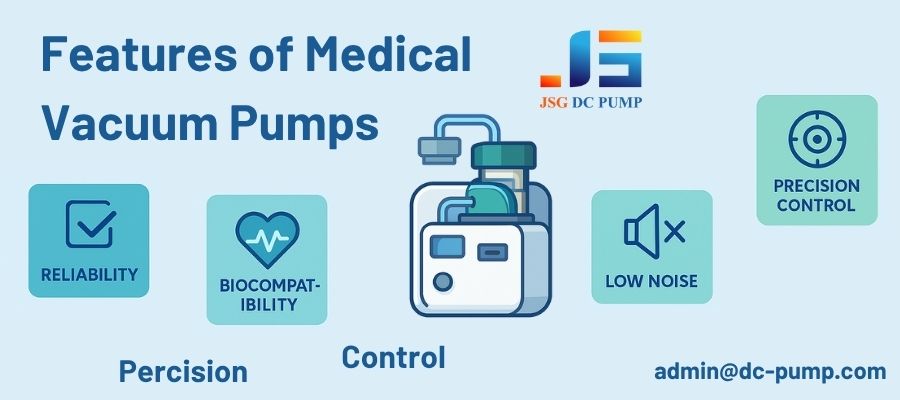
In my experience at JSG DC PUMP, developing pumps for medical applications requires a deep understanding of these critical factors. Let’s break them down:
- Reliability and Long Lifespan: Medical devices often run for extended periods or must be ready at a moment’s notice. The pump must perform consistently. We design our pumps, like many of our 300+ prototypes, for longevity.
- Low Noise and Vibration: Patient comfort is paramount. Pumps operating near a patient, especially in wearables or bedside devices, must be quiet and produce minimal vibration. This is a key design focus for us.
- Oil-Free Operation: This is non-negotiable in most medical scenarios. Oil-free pumps prevent contamination of the air or fluid path, which is essential for patient safety and sample integrity.
- Biocompatible Materials: Any part of the pump that could come into contact with bodily fluids or medical gases must be made from materials that are non-toxic and don’t react with biological substances.
- Precision Control: Many medical applications, like drug delivery or negative pressure wound therapy, require very precise vacuum levels. The pump must be controllable to meet these exact specifications.
- Compact Size and Low Power Consumption: For portable and wearable devices, the pump must be tiny and draw minimal power to ensure battery longevity.
These aren’t just desirable features; they are often mandatory requirements for medical device approval.
How do I know what size vacuum pump I need?
Choosing the wrong pump size can lead to system failure or inefficiency. Understanding your application’s specific vacuum requirements is the first step to making the right choice.
To determine the right vacuum pump size, you need to identify the required vacuum level (e.g., negative pressure in kPa or mmHg), the necessary flow rate (LPM or mL/min), and consider the operational duty cycle and physical space constraints.

This is a question I encounter frequently from engineers and designers. At JSG DC PUMP, we guide customers through this process. Here’s a more detailed look:
-
Vacuum Level (Ultimate Vacuum):
What is the maximum negative pressure your application needs? This is often expressed in kPa, mbar, mmHg, or inHg. For example, gentle suction for wound care might need -20 kPa, while some laboratory applications might require much deeper vacuums.
2.Flow Rate (Pumping Speed):
How quickly does the air or gas need to be removed from the volume? This is measured in Liters Per Minute (LPM) or milliliters per minute (mL/min). A larger volume or a need for rapid evacuation will require a higher flow rate.
3.Duty Cycle:
Will the pump run continuously (100% duty cycle) or intermittently? A pump rated for intermittent use might overheat if run continuously. This impacts the thermal design and longevity of the pump.
4.Power Consumption:
Especially for battery-operated devices, the pump’s power draw (Watts or Amps at a given Voltage) is critical. Higher performance often means higher power consumption.
5.Physical Dimensions and Weight:
What are the maximum allowable size (L x W x H) and weight for the pump within your device? This is often a primary driver for “small size” vacuum pumps.
6.Noise and Vibration:
What are the acceptable levels for your application? Medical devices near patients have stricter limits.
7.Media Compatibility:
What gas will the pump be handling? Corrosive gases require special materials for wetted parts.
For instance, a portable medical suction unit might need a moderate vacuum level (e.g., -50 to -80 kPa) and a decent flow rate (e.g., 5-15 LPM) to be effective, while fitting into a handheld device and running quietly on battery. It’s about balancing these factors.
What are small vacuum pumps used for?
You might be surprised by the sheer variety of applications for these tiny workhorses. From saving lives to enhancing our daily gadgets, their uses are diverse and growing rapidly.
Small vacuum pumps are used in medical suction devices, portable diagnostic tools, wearable technology for haptic feedback or sensor adhesion, smart instruments for sample handling, gas detection systems, and even compact pick-and-place robotics.
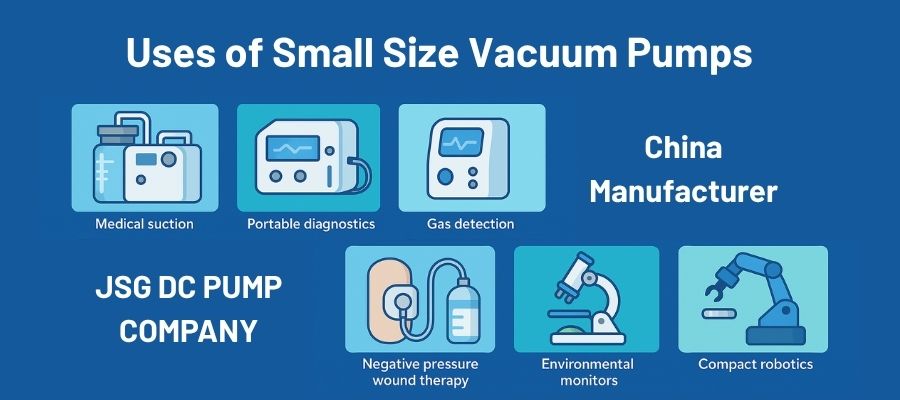
The versatility of our JSG DC PUMP products, with over 300 micro pump prototypes, reflects this wide range of uses. Let’s look at some examples:
- Medical Field:
- Portable Suction Units: For clearing airways or wounds.
- Negative Pressure Wound Therapy (NPWT): Promoting healing by applying controlled vacuum.
- Breast Pumps: Compact and quiet operation is key.
- Gas Sampling: In patient monitors like capnographs.
- Automated Pipetting Systems: For precise liquid handling in labs.
- Wearable Technology:
- Haptic Feedback: Creating localized suction for tactile sensations.
- Device Adhesion: Ensuring smart patches or sensors stay securely on the skin.
- Microfluidic Cooling/Heating: For personal thermal regulation.
- Smart Instruments & Consumer Electronics:
- Environmental Monitors: Drawing air samples for analysis.
- Pick-and-Place Nozzles: In small-scale automated assembly or lab automation.
- Coffee Machines: Some advanced models use vacuum for frothing or brewing processes.
- Robotic Cleaners: Creating suction for dust and debris collection.
- Automotive:
- Vacuum Actuation: For small valves or controls in specific automotive systems.
- Sensor Cleaning: Miniature systems to keep optical sensors clear.
The common thread is the need for reliable vacuum generation in a space-constrained environment, often with requirements for low noise and high efficiency.
What are medical suction pumps?
When you hear “medical suction,” what comes to mind? These devices are critical in healthcare, playing a vital role in patient care across various settings.
Medical suction pumps are specialized vacuum pumps designed to safely remove fluids, secretions, or particulate matter from a patient’s body, used in surgical procedures, airway management, and wound drainage.
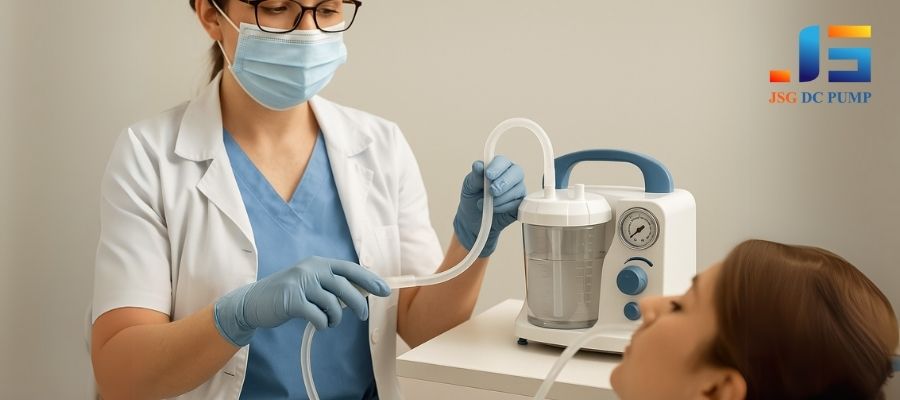
At JSG DC PUMP, we understand the critical nature of medical suction. These aren’t just any pumps; they must meet stringent medical standards. Medical suction pumps typically consist of a vacuum pump, a collection canister for the aspirated fluids, tubing, and often a regulator to control the suction level. They can range from large, cart-based units for operating rooms to small, portable devices for emergency use or home healthcare. Key characteristics include:
- Controlled Vacuum Levels: Adjustable to suit different procedures and patient sensitivities.
- Safety Features: Overflow protection to prevent fluids from entering the pump mechanism, and filters to prevent cross-contamination.
- Hygienic Design: Easy to clean and disinfect, with disposable components like canisters and tubing.
- Reliability: Essential for life-support functions like clearing an obstructed airway.
Applications are diverse:- Surgical Suction: Clearing blood and fluids from the surgical site.
- Airway Suction: Removing mucus or foreign objects from the trachea or bronchial tubes.
- Dental Suction: Removing saliva and debris during dental procedures.
- Gastrointestinal Suction: Emptying the stomach or intestines.
- Wound Drainage: Post-operative removal of fluids from a wound site.
The underlying vacuum technology must be robust and precisely engineered for these demanding tasks.
Why Choose JSG DC PUMP Vacuum Pumps Small Size?
With many options available, why consider JSG DC PUMP for your small vacuum pump needs? Our experience and dedication to quality set us apart in this specialized field.
Choose JSG DC PUMP for small vacuum pumps due to our 22+ years of industry experience, extensive range of over 300 prototypes, global export expertise, and commitment to high performance, low noise, and long lifespan, supporting OBM, ODM, and OEM.

As an engineer here, I’m proud of what JSG DC PUMP offers. We’re not just a manufacturer; we’re a partner in innovation. Our Shenzhen Jingsuguang Technology Co., Ltd. has built a reputation for excellence. Here’s why customers trust us:
- Deep Expertise: Over two decades in R&D and production of micro pumps means we understand the nuances of vacuum technology and fluid dynamics at a small scale.
- Customization Capabilities: With OBM, ODM, and OEM cooperation models, we can tailor solutions to meet unique customer needs. Whether you need a standard model or a completely custom design, we have the flexibility.
- Proven Quality: Our products are designed for high pressure, high flow, low noise, and long lifespan. Exporting globally for 10 years to demanding markets in South Korea, Europe, the USA, Japan, and Australia speaks to our consistent quality.
- Comprehensive Range: Our portfolio includes vacuum pumps, air pumps, piston pumps, and diaphragm pumps. This breadth allows us to recommend the truly best fit for an application, not just push one type of technology.
- Application Focus: Our pumps are widely used in critical industries like medical, cosmetology, household appliances, and instrumentation. We understand the specific demands of these sectors.
When you choose JSG DC PUMP, you’re choosing a partner committed to providing high-quality mini pump solutions backed by years of experience and a dedication to sharing our expertise.
How to Select the Right small size vacuum pump for Your Application?
Making the final choice for a small vacuum pump can seem daunting. A systematic approach ensures you select a pump that performs reliably and efficiently for your specific needs.
To select the right small vacuum pump, clearly define your required vacuum level and flow rate, consider power, size, noise constraints, media compatibility, and expected lifespan, then consult with experienced suppliers.
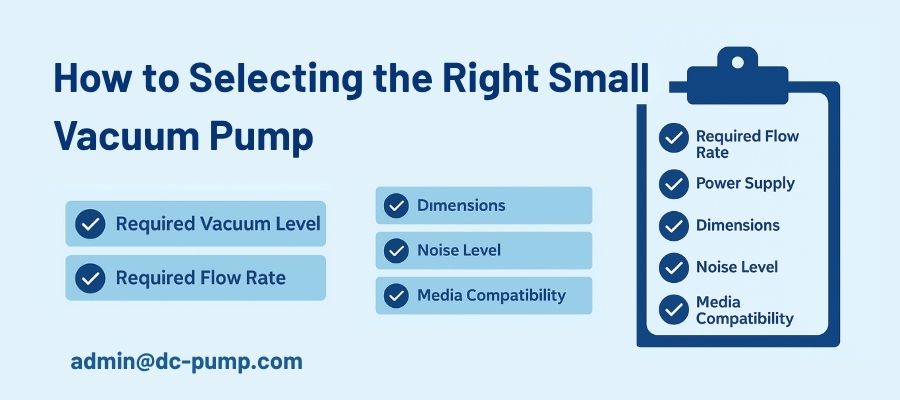
Guiding customers through this selection process is a core part of what we do at JSG DC PUMP. Here’s a practical checklist to help you:
-
Define Performance Requirements:
- Target Vacuum Level: What is the minimum negative pressure (e.g., -kPa, mmHg) needed?
- Required Flow Rate: How much air/gas needs to be moved per unit of time (e.g., LPM, mL/min)?
- Evacuation Time: If applicable, how quickly must a specific volume be evacuated?
-
Operational Parameters:
- Duty Cycle: Continuous or intermittent operation?
- Power Supply: Voltage (VDC) available and maximum current (A) or power (W) consumption allowed. This is critical for battery life in portable devices.
-
Physical and Environmental Constraints:
- Size and Weight: What are the maximum dimensions and weight the pump can have?
- Mounting: How will the pump be integrated into your device?
- Noise and Vibration: What are the acceptable limits for your application?
- Operating Temperature Range: The ambient conditions the pump will experience.
-
Media Compatibility:
- What gas or fluid will the pump handle? Ensure wetted materials (pump head, diaphragm, valves) are compatible to prevent corrosion or degradation.
-
Lifespan and Maintenance:
- What is the expected operational life of the pump in hours or cycles?
- Are there any maintenance requirements or serviceable parts?
-
Consult Experts:
Don’t hesitate to talk to pump specialists like our team at JSG DC PUMP. Provide us with your detailed requirements, and we can help identify the best standard product or discuss a custom solution from our extensive range of over 300 prototypes. We’ve helped countless clients match the right pump to their vision.
By systematically addressing these points, you can confidently choose a small vacuum pump that meets your technical and commercial objectives.
Conclusion
Small vacuum pumps are vital for medical, wearable, and smart devices. JSG DC PUMP offers experienced guidance and quality pumps to meet diverse, compact application needs effectively.


